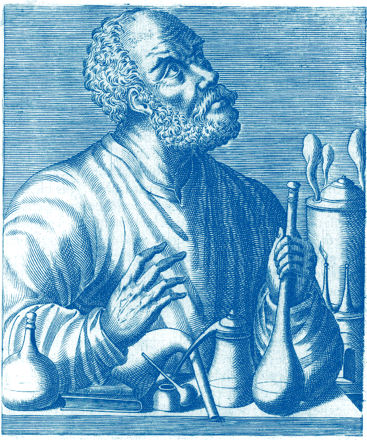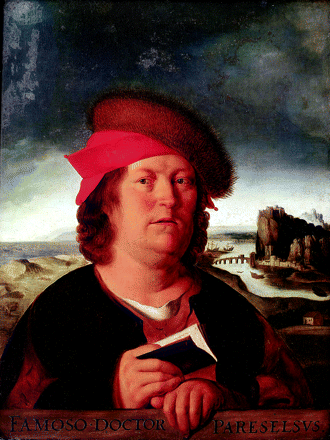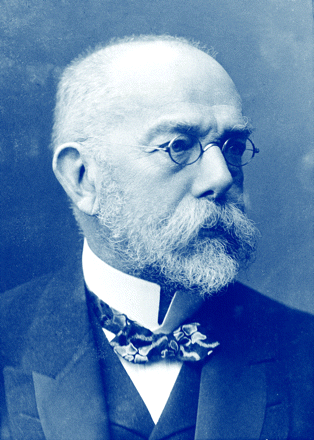A Brief History of Potable Gold
- Stata Norton, PhD
Gold has a long history as a therapeutic agent, first as the triturated metal, then as a soluble salt made by the alchemists and used as an elixir of life, later incorporated into pharmacopoeias for various illnesses, currently used to treat selected medical conditions. This article provides an overview of the medicinal uses of gold and looks at how the use and value of gold as a medicine have changed over thousands of years.
Early History
Gold was mined as early as the First Dynasty (2900 BCE) of Egypt in the Ethiopian and Nubian deserts east of the Nile. Egyptian mineralogists soon learned to purify gold (1), and gold objects were produced in this period as well as in the Early Dynastic period of Ur, in Babylonia (2500 BCE) (2). Herodotus reported that Darius, king of the Persians (558 486 BCE), received gifts of unrefined gold and gold dust from the Ethiopians whose land contained much gold (3). Herodotus further detailed a process, used in India, for the procurement of gold from sand (3).
Production of Potable Gold
Because gold was considered indesctructible, it is not surprising that the metal was thought to be of great therapeutic value. Gold was known to be insoluble in water and other solvents available to physicians. Colloidal gold in which gold was ground so finely that it could be suspended in aqueous solvents was implemented as a remedy; however, there is little record that colloidal gold potions ever had much therapeutic success.
The aim of early alchemists was to produce truly potable gold: gold in a form that was soluble in water.
Success in this was achieved in the eighth century CE by the Arabian alchemist, Jabir ibn Hayyan, usually identified as “Geber” in European historical records, who produced the terchloride of gold by dissolving gold in aqua regia (4). The secrets of alchemy discovered by Jabir were transmitted to the European alchemists (two manuscripts from the ninth and tenth centuries still exist). Aqua regia is a mixture of nitric and hydrochloric acids and the formula for producing nitric acid became well known to European alchemists. Paracelsus (1493 1541) gave a formula: distillation of a mixture of saltpeter (potassium nitrate) and vitriol (ferrous sulfate) yielded aqua fortis (nitric acid) (5). Some alchemical formulas for aqua regia did not require separate production of hydrochloric acid. Biringuccio (1480 1539), a mineralogist and contemporary of Paracelsus, offered the following mixture to produce aqua regia directly. First, he described the type of furnace necessary to produce aqua fortis and noted that the distillate of saltpeter, rock alum (potassium aluminum sulfate), vitriol, and sal ammoniac (ammonium chloride), with the addition of a little verdigris (copper sulfate) would dissolve gold (6). He called the distillate not aqua regia, but rather a form of aqua fortis. The addition of a chloride salt allowed the development of hydrochloric acid. Simpler formulas became available. In his treatise on chemistry, Wilson in 1699 gave his method for making aurum potabile (with somewhat cryptic identification of ingredients) by “dissolving 4 oz of gold in 1 lb of spirit of nitre [nitric acid] with a fifth cohobation [distillation] with new spirit of nitre bezoart [ammonium chloride]” (7). The word “bezoart” refers to an antidote. By the end of the seventeenth century, potable gold was a familiar chemical product. Robert Boyle as AuCl3 noted in 1661 that aqua regia was commonly used to reduce gold to a liquid that could be precipitated into a crystalline salt (8). The principle method for making potable gold after the gold was dissolved in nitric plus hydrochloric acids was to distill the solution with water and to precipitate the gold salt with a solution of potassium hydroxide (4).
Therapy with Potable Gold
The ability of alchemists to solubilize gold was considered by many to be a great gift bestowed on medicine. In the early Renaissance and during the following centuries, potable gold was expected to be the elixir capable of curing all diseases and was employed in a wide range of illnesses. Large doses of potable gold caused gastrointestinal irritation, and continued use resulted in kidney damage and other toxic effects called “auric fever.” Nevertheless, low doses were considered beneficial in many conditions. One effect of potable gold was thought to be its action on the central nervous system. Paracelsus, who was greatly interested in the use of drugs made by alchemists, wrote a treatise on “Diseases that deprive man of his reason,” and included potable gold as one of his medicamenta comfortativa, useful in epilepsy, mania, St. Vitus dance (Sydenham’s chorea), melancholy, and “suffocation of the intellect” (hysteria) (9). A contemporary of Paracelsus, Giovanni Andrea (d. 1562), a friar of the Order of St. Jerome in Italy, compiled a book of remedies used by the friars for treatment of the sick in which he noted that oro potabile was used to treat lepra (psoriasis), ulcer, fistula, and epilepsy, and could prevent an apoplectic stroke (10). The use of potable gold was sufficiently common to achieve notice in the general literature of the time and Shakespeare was among those who commented on potable gold. In Henry IV, Prince Henry blames the gold crown for his father’s illness:
“I spake unto this crown as having sense, And thus upbraided it: the care on thee depending Hath fed upon the body of my father;
Therefore, thou best of gold art worst of gold: Other, less fine in carat, is more precious, Preserving life in medicine potable.”
After Robert Koch in 1890 reported that low concentrations of gold salts were bactericidal, interest in gold salts in treating tuberculosis and syphilis increased (11). Although gold chloride continued to be used, a mixture of gold and sodium chlorides became the official form of soluble gold in many of the European pharmacopoeias in the 19th century. The US Pharmacopoeia listed Auri et Sodii Chloridum as an official drug until the tenth edition in 1926. In the late nineteenth century, a textbook on therapeutics recommended this preparation of soluble gold in tablet form for dyspepsia, cirrhosis of the kidney, spinal sclerosis, progressive general paralysis, late manifestations of syphilis, tuberculosis, depression, hypochondria, hysteria, and impotence. The author noted specifically that oral gold chloride had been reported to be useful in a case of lupus erythematosus (12). In the same period, other salts were made and tried, including gold cyanide and gold bromide. Injection of gold salts became more common as it was recognized that gold salts were poorly absorbed from the intestinal tract.
A sidelight in the history of gold salts is Keeley’s “gold cure” for alcoholism. At the height of the temperance movement in the United States, that culminated in the eighteenth Amendment to the Constitution prohibiting the sale of alcoholic beverages, Dr. L.E. Keeley opened a clinic in Illinois in 1879 for the treatment of alcoholism. Dr. Keeley claimed that alcoholism was a disease and he could cure it by a three-week sojourn in his clinic. His cure consisted of a secret remedy taken twice a day plus four daily injections of a tonic. In the US Dispensatory of 1907, the “Keeley cure” was described as consisting of the “administration of ascending doses of the double chloride of gold and sodium and injection every 3 hours of very minute doses of atropine and strychnine” (13). Other ingredients in the “cure” have been reported to be apomorphine, cinchona, aloin and ammonium chloride (14), all of which in low doses in the 19th century were considered to be “hepatic stimulants.” For example, Shoemaker recommended pills containing aloes, belladonna, and strychnine for “liver problems” (12). There is no evidence to suggest that the chlorides of gold and sodium or other medications listed in the “Keeley cure” were effective, except that the three-week cure seems to have been a kind of psychological conditioning against alcohol. However, physicians carrying out the cure were confident that during the cure the patients would reject alcohol even when available (15). This suggests a disulfiram-like effect of the drugs, as well as reports that some patients developed toxic psychoses and that there were some deaths from cardiovascular problems (16). Both toxic psychoses (17) and serious cardiovascular effects (11) may result from acetaldehyde accumulation in the presence of compounds that, like disulfiram, inhibit aldehyde dehydrogenase.
By the beginning of the twentieth century, most writers of pharmacology texts were dismissive of therapy with all gold compounds. Sollman’s comments were brief, noting that gold salts had fallen into disuse and attempts at resuscitation of the use of gold had doubtful justification. He noted, however, a report of 1913 claiming successful results from intravenous injection of “gold-potassic cyanid” in a case of lupus (18). In the same period, Cushny was more definite, writing that repeated attempts to introduce gold salts in treatment of diverse conditions were unsuccessful and proposed that the mixture of gold and sodium chloride was of no value except through suggestion (19). Nevertheless, confident reports of the uselessness of gold salts were premature. There were other case reports of successful use of gold compounds in lupus. Then, in 1927 Schamberg and Wright described successful treatment of a group of patients with lupus erythematosus with injections of gold sodium thiomalate (20). Two years later, Forestier published a report of treatment of a group of patients with rheumatoid arthritis using injections of gold sodium thiosulfate (21). In the following years, the evidence for good results with these gold compounds in some patients accumulated. By 1949, Sollman accepted that these gold salts were effective by intramuscular injection in about two-thirds of patients with lupus and nearly half the patients with rheumatoid arthritis, although the mechanism was unknown (22). Over the next fifty years the effectiveness of these gold compounds in some autoimmune diseases continued to be reported and search for mechanism of action along with interest in development of additional compounds continued.
Mechanisms of Action
Distinction between the actions of gold possessing a different valence in different compounds has been of some interest relative to effectiveness as anti-inflammatory drugs. Both gold thiomalate and gold thioglucose contain Au(I) whereas gold chloride contains Au(III). Both Au(I) and Au(III) complexes are effective inhibitors of specific enzymes, and the inhibition of selected enzymes by gold compounds has been proposed as a mechanism of benefit in rheumatoid arthritis. The link between autoimmune diseases and inflammatory responses has resulted in extensive investigation into the sites of action of gold compounds on mitochondria and on activation of nuclear factor kappa B (NF-kappa B).
Although oral administration of gold compounds has not been recommended because absorption from the intestine is poor and erratic, animal experiments have been carried out which point to the possibility that oral doses of two gold compounds (auranofin and triethylphosphine gold chloride) are anti-inflammatory, as measured by significantly reduced kaolin-induced paw edema in rats and ultra violet-induced erythema in guinea pigs (23). However, intramuscular injections are the usual route in therapy.
One action of gold compounds as anti-inflammatory agents that has received attention is the ability of these compounds to inhibit expression of NF-kappa B and subsequent inflammatory reactions. Auranofin (S-triethylphosphine gold(I)-2,3,4,6-tetra-O-acetyl-1-thio-beta-D-glucopyranoside) inhibits mitochondrial thioredoxin reductase (24). This occurs at levels of auranofin that do not affect the mitochondrial respiration chain (25). There is evidence that the flavoprotein, thioredoxin reductase (TrxR), regulates the activity of NF-kappa B. Tumor necrosis factor induces TrxR1, a cytosolic isozyme of thioredoxin reductase, that enhances DNA binding of NF-kappa B (26). In addition it has been shown that gold compounds do not affect direct binding but inhibit nuclear translocation of NF-kappa B (27). Both Au(I) and Au(III) compounds inhibit TrxR. Ligand configuration, not oxidative state, is reported to be the critical component for development of therapeutic gold compounds (28). The anti-inflammatory actions of gold compounds might also relate to blocking the activity of other enzymes, including interaction with Cys179 of Ikappa B kinase (29) and interference with phosphorylation of Janus kinase 1 (Jak1) (30).
Recent Therapeutic Developments
Therapeutic uses for gold compounds in addition to rheumatoid arthritis and lupus are being investigated. Gold salts have some value in psoriatic arthritis (31). Recently successful use of gold thiomalate in refractory pemphigus vulgaris, a severe autoimmune condition, has been reported (32). The same compound has been shown to be a specific inhibitor of signaling pathway the oncogenic atypical protein kinase Cι (33) and gold thiomalate is under investigation for treatment of non-small-cell lung cancer.
The prolonged efforts throughout medical history to discover the therapeutic value of gold has included periods of great enthusiasm and complete rejection. Current research poses a hopeful note that the rightful place of gold compounds in medicine is being established.
- © American Society for Pharmacology and Experimental Theraputics 2008
References

Stata Norton, PhD, is an Emeritus Professor in the Department of Pharmacology, Toxicology, and Therapeutics, University of Kansas Medical Center, Kansas City, KS. She has published over 120 research articles, reviews, and book chapters on neuropharmacology and neurotoxicology, especially on the effects of drugs and radiation on the developing central nervous system. E-mail snorton{at}kumc.edu; fax (913) 588 7501.






